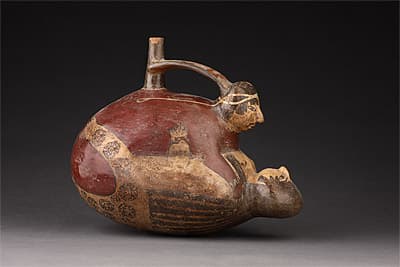
NAZCA culture South coast 100 – 700 AD
Bridge vessel in the form of a couple 100-700 AD ceramic16.6 (h) x 20.1 (w) x 11.7 (d) cm Museo Larco, Lima Photograph: Daniel Giannoni
Although Moche potters made thousands of erotic ceramics (cats 102–106), other cultures also created works showing human or animal sexual relations. The vessel with spout and handle portrays a man and woman coupling face to face. It was found at the Huanchaco site in the Nazca Valley on the southern coast of Peru. Like many ancient Peruvian vessels with spouts, was constructed to whistle when one blows into the spout.
Only the figures’ heads and the man’s arms stand in relief, as their bodies are smoothed into the oval that makes up the vessel’s form. Like most Nazca pots, it was probably made:
by a combination of modelling and coiling. The bases were generally shaped by direct modelling and then placed on a turntable, after which the walls would be built up by modelling and coiling, sometimes with the aid of a paddle and anvil.1
Nazca potters were noted for their polychrome slip painting—here the maker used cream, rich red-brown, red and black. The man has a corded head band, the woman’s body is painted with ceremonial patterns (see cat. 168), and both wear woven wristbands or bracelets. Her long hair is braided, but with short locks around the face. The body of the ceramic is enhanced by the technique of burnishing.
Christine Dixon
1. Christopher B. Donnan, Ceramics of ancient Peru, Los Angeles: Fowler Museum of Cultural History, UCLA 1992, p. 43. Donnan cites research by Patrick Carmichael, ‘Nasca ceramic production’, in Sergio Purin, Inca—Pérou: 3000 ans d’histoire, Ghent: Imschoot 1990, and Sergio Purin, ‘Nasca pottery construction’, Nawpa Pacha, no. 24, 1990, pp. 31–48.
Although Moche potters made thousands of erotic ceramics (cats 102–106), other cultures also created works showing human or animal sexual relations. The vessel with spout and handle portrays a man and woman coupling face to face. It was found at the Huanchaco site in the Nazca Valley on the southern coast of Peru. Like many ancient Peruvian vessels with spouts, was constructed to whistle when one blows into the spout.
Only the figures’ heads and the man’s arms stand in relief, as their bodies are smoothed into the oval that makes up the vessel’s form. Like most Nazca pots, it was probably made:
by a combination of modelling and coiling. The bases were generally shaped by direct modelling and then placed on a turntable, after which the walls would be built up by modelling and coiling, sometimes with the aid of a paddle and anvil.1
Nazca potters were noted for their polychrome slip painting—here the maker used cream, rich red-brown, red and black. The man has a corded head band, the woman’s body is painted with ceremonial patterns (see cat. 168), and both wear woven wristbands or bracelets. Her long hair is braided, but with short locks around the face. The body of the ceramic is enhanced by the technique of burnishing.
Christine Dixon
1. Christopher B. Donnan, Ceramics of ancient Peru, Los Angeles: Fowler Museum of Cultural History, UCLA 1992, p. 43. Donnan cites research by Patrick Carmichael, ‘Nasca ceramic production’, in Sergio Purin, Inca—Pérou: 3000 ans d’histoire, Ghent: Imschoot 1990, and Sergio Purin, ‘Nasca pottery construction’, Nawpa Pacha, no. 24, 1990, pp. 31–48.
Although Moche potters made thousands of erotic ceramics (cats 102–106), other cultures also created works showing human or animal sexual relations. The vessel with spout and handle portrays a man and woman coupling face to face. It was found at the Huanchaco site in the Nazca Valley on the southern coast of Peru. Like many ancient Peruvian vessels with spouts, was constructed to whistle when one blows into the spout.
Only the figures’ heads and the man’s arms stand in relief, as their bodies are smoothed into the oval that makes up the vessel’s form. Like most Nazca pots, it was probably made:
by a combination of modelling and coiling. The bases were generally shaped by direct modelling and then placed on a turntable, after which the walls would be built up by modelling and coiling, sometimes with the aid of a paddle and anvil.1
Nazca potters were noted for their polychrome slip painting—here the maker used cream, rich red-brown, red and black. The man has a corded head band, the woman’s body is painted with ceremonial patterns (see cat. 168), and both wear woven wristbands or bracelets. Her long hair is braided, but with short locks around the face. The body of the ceramic is enhanced by the technique of burnishing.
Christine Dixon
1. Christopher B. Donnan, Ceramics of ancient Peru, Los Angeles: Fowler Museum of Cultural History, UCLA 1992, p. 43. Donnan cites research by Patrick Carmichael, ‘Nasca ceramic production’, in Sergio Purin, Inca—Pérou: 3000 ans d’histoire, Ghent: Imschoot 1990, and Sergio Purin, ‘Nasca pottery construction’, Nawpa Pacha, no. 24, 1990, pp. 31–48.

